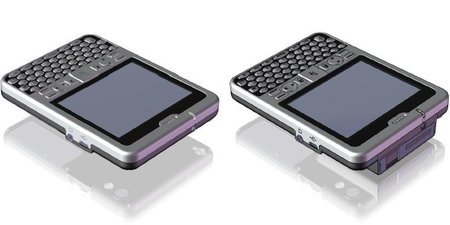“EDA” runs Android
Jan 7, 2009 — by LinuxDevices Staff — from the LinuxDevices Archive — 1 views Israeli SBC (single board computer) specialist CompuLab announced an “enterprise digital assistant” that enterprises can use to build custom devices with Android or Angstrom Linux. The “Exeda” has a 3.5-inch VGA touchscreen, QWERTY keyboard, touchpad, two-megapixel camera, microSD slot, GPS, and optional cellular… capabilities, says CompuLab.
Israeli SBC (single board computer) specialist CompuLab announced an “enterprise digital assistant” that enterprises can use to build custom devices with Android or Angstrom Linux. The “Exeda” has a 3.5-inch VGA touchscreen, QWERTY keyboard, touchpad, two-megapixel camera, microSD slot, GPS, and optional cellular… capabilities, says CompuLab.
(Click here for a larger view of an Exeda running Android)
The Exeda is touted as an “unusual development platform,” and, indeed, we haven't seen one quite like it. It resembles a typical PDA (personal digital assistant), but as an “EDA” may be more amenable to custom software development or even small-volume custom hardware runs.
On the software side, the device is said to be supplied with the open source U-boot boot loader, allowing it to boot into Angstrom Linux and the Google-sponsored Android Linux platform, as well as Windows CE 6.0 and Windows Mobile (pictured here). CompuLab says the Exeda includes complete BSPs (board support packages) plus detailed documentation.
 CompuLab's EM-X270 SBC (Click image for further information) |
On the hardware side, the Exeda is “built of embedded components which guarantee long term availability, and can be configured to order,” according to the company. Like the tiny EM-X270 SBC (right) that CompuLab introduced in 2007, the device is based on a Marvell PXA270 processor, and integrates a touchscreen LCD controller, WAN, WLAN, and WPAN wireless, and GPS.
Measuring 4.9 x 3.7 x 0.6 inches, the Exeda is wider than most phones, or even many handheld computers. This form factor provides room for a 3.5-inch transflective touchscreen display with VGA resolution, a backlit 56-key QWERTY keyboard, and even a small capacitive Synaptics touchpad, CompuLab says.

Exeda, with and without expansion modules
(Click to enlarge)
Inside, the Exeda has space for an expansion connector, plus an application-specific extension board. (We expect the device's expansion connector may be similar to the one found on the EM-X270, a block diagram of which is available, here.) A sample extension board with Ethernet, SDIO, and JTAG interfaces is available separately, CompuLab adds.
The Exeda comes with 128MB of RAM — apparently soldered on — and a 520MHz Marvell PXA270 processor. For persistent storage, there are two banks of internal flash memory, for a total of 1GB. According to CompuLab, the device also includes an SDHC-compliant microSD expansion slot.
Again following in the footsteps of CompuLab's EM-X270 SBC, the Exeda includes a GPS receiver, said to be based on SiRF's ever-popular starIII chipset. Meanwhile, there's an unlocked SIM slot, and voice/data cellular capabilities can be a purchaser's choice of GSM/GPRS, CDMA or 3G UMTS modules, the company says.
Finally, the Exeda also includes a two megapixel camera with flash, plus a built-in microphone and speaker. Interfaces include an RS232 serial port and two USB ports — both host and device.
Features and specifications listed by CompuLab for the Exeda include:
- Processor — Marvell PXA270 clocked at 520MHz
- Memory — 128MB of RAM and 1GB of flash
- Display — 3.5-inch touchscreen display with VGA resolution
- Keys — 56-key backlit QWERTY keyboard, directional buttons, mouse buttons, calling keys, and capacitive Synaptics touchpad
- Camera — Two megapixel camera with flash
- Wireless:
- WAN — GSM/GPRS, CDMA, or UMTS (purchaser-specified)
- WPAN — Bluetooth 2.0
- WLAN — 802.11b/g
- GPS
- WAN — GSM/GPRS, CDMA, or UMTS (purchaser-specified)
- Other I/O:
- 2 x USB (1 x host, 1 x device)
- 1 x RS232
- 10/100 Ethernet (on available extension board)
- JTAG (on extension board)
- 2 x USB (1 x host, 1 x device)
- Expansion:
- microSD slot
- SDIO slot (on extension board)
- microSD slot
- Battery — 3000mAh lithium-ion battery
- Dimensions — 4.9 x 3.7 x 0.6 inches (126 x 96 x 16mm)
According to CompuLab, the Exeda will be available in March, at which time pricing will be published. The device will be demonstrated this week in the company's CES booth, North 403.
This article was originally published on LinuxDevices.com and has been donated to the open source community by QuinStreet Inc. Please visit LinuxToday.com for up-to-date news and articles about Linux and open source.